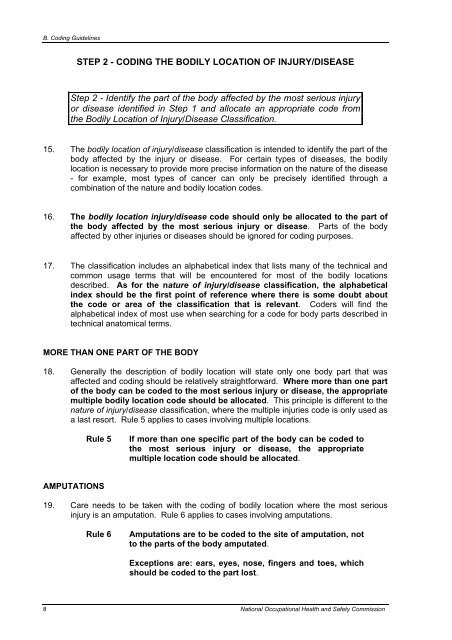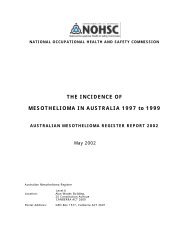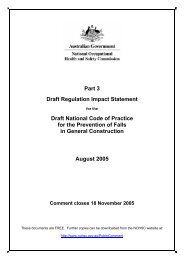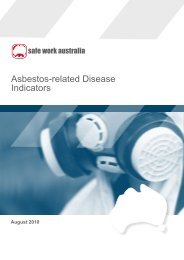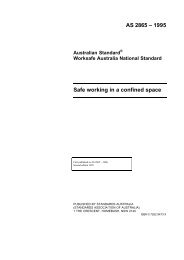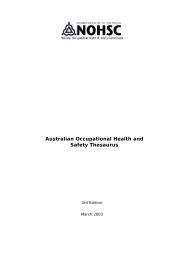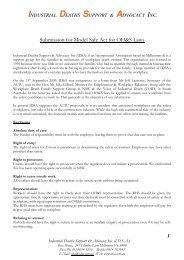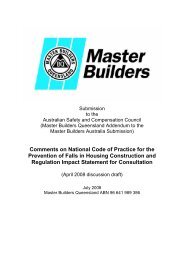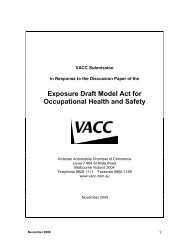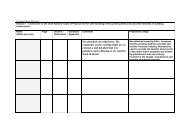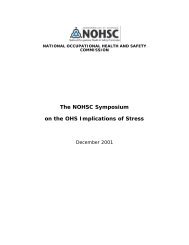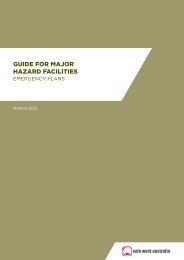- Page 1 and 2: Type of OccurrenceClassification Sy
- Page 3 and 4: FOREWORDThe National Occupational H
- Page 5: CONTENTSA. INTRODUCTION 1B. CODING
- Page 8 and 9: A. Introduction• Nature of Injury
- Page 10 and 11: B. Coding GuidelinesSTEP 1 - CODING
- Page 12 and 13: B. Coding Guidelines10. The nature
- Page 16 and 17: B. Coding GuidelinesSTEP 3 - CODING
- Page 18 and 19: B. Coding Guidelinesnot need to be
- Page 20 and 21: B. Coding GuidelinesROLLOVERS36. A
- Page 22 and 23: B. Coding Guidelines43. The agency
- Page 24 and 25: B. Coding Guidelines18 National Occ
- Page 26 and 27: C. Selected Examples of Injury/Dise
- Page 28 and 29: C. Selected Examples of Injury/Dise
- Page 30 and 31: C. Selected Examples of Injury/Dise
- Page 32 and 33: D. Nature of Injury/Disease Classif
- Page 34 and 35: D. Nature of Injury/Disease Classif
- Page 36 and 37: D. Nature of Injury/Disease Classif
- Page 38 and 39: D. Nature of Injury/Disease Classif
- Page 40 and 41: D. Nature of Injury/Disease Classif
- Page 42 and 43: D. Nature of Injury/Disease Classif
- Page 44 and 45: D. Nature of Injury/Disease Classif
- Page 46 and 47: D. Nature of Injury/Disease Classif
- Page 48 and 49: D. Nature of Injury/Disease Classif
- Page 50 and 51: D. Nature of Injury/Disease Classif
- Page 52 and 53: D. Nature of Injury/Disease Classif
- Page 54 and 55: D. Nature of Injury/Disease Classif
- Page 56 and 57: D. Nature of Injury/Disease Classif
- Page 58 and 59: D. Nature of Injury/Disease Classif
- Page 60 and 61: D. Nature of Injury/Disease Classif
- Page 62 and 63: D. Nature of Injury/Disease Classif
- Page 64 and 65:
D. Nature of Injury/Disease Classif
- Page 66 and 67:
D. Nature of Injury/Disease Classif
- Page 68 and 69:
D. Nature of Injury/Disease Classif
- Page 70 and 71:
D. Nature of Injury/Disease Classif
- Page 72 and 73:
D. Nature of Injury/Disease Classif
- Page 74 and 75:
D. Nature of Injury/Disease Classif
- Page 76 and 77:
D. Nature of Injury/Disease Classif
- Page 78 and 79:
D. Nature of Injury/Disease Classif
- Page 80 and 81:
D. Nature of Injury/Disease Classif
- Page 82 and 83:
D. Nature of Injury/Disease Classif
- Page 84 and 85:
D. Nature of Injury/Disease Classif
- Page 86 and 87:
D. Nature of Injury/Disease Classif
- Page 88 and 89:
D. Nature of Injury/Disease Classif
- Page 90 and 91:
D. Nature of Injury/Disease Classif
- Page 92 and 93:
D. Nature of Injury/Disease Classif
- Page 94 and 95:
D. Nature of Injury/Disease Classif
- Page 96 and 97:
D. Nature of Injury/Disease Classif
- Page 98 and 99:
D. Nature of Injury/Disease Classif
- Page 100 and 101:
D. Nature of Injury/Disease Classif
- Page 102 and 103:
D. Nature of Injury/Disease Classif
- Page 104 and 105:
D. Nature of Injury/Disease Classif
- Page 106 and 107:
E. Bodily location of Injury/Diseas
- Page 108 and 109:
E. Bodily location of Injury/Diseas
- Page 110 and 111:
E. Bodily location of Injury/Diseas
- Page 112 and 113:
E. Bodily location of Injury/Diseas
- Page 114 and 115:
E. Bodily location of Injury/Diseas
- Page 116 and 117:
E. Bodily location of Injury/Diseas
- Page 118 and 119:
E. Bodily location of Injury/Diseas
- Page 120 and 121:
E. Bodily location of Injury/Diseas
- Page 122 and 123:
E. Bodily location of Injury/Diseas
- Page 124 and 125:
E. Bodily location of Injury/Diseas
- Page 126 and 127:
E. Bodily location of Injury/Diseas
- Page 128 and 129:
E. Bodily location of Injury/Diseas
- Page 130 and 131:
E. Bodily location of Injury/Diseas
- Page 132 and 133:
E. Bodily location of Injury/Diseas
- Page 134 and 135:
E. Bodily location of Injury/Diseas
- Page 136 and 137:
E. Bodily location of Injury/Diseas
- Page 138 and 139:
E. Bodily location of Injury/Diseas
- Page 140 and 141:
E. Bodily location of Injury/Diseas
- Page 142 and 143:
E. Bodily location of Injury/Diseas
- Page 144 and 145:
E. Bodily location of Injury/Diseas
- Page 146 and 147:
E. Bodily location of Injury/Diseas
- Page 148 and 149:
E. Bodily location of Injury/Diseas
- Page 150 and 151:
F. Mechanism of Incident Classifica
- Page 152 and 153:
F. Mechanism of Incident Classifica
- Page 154 and 155:
F. Mechanism of Incident Classifica
- Page 156 and 157:
F. Mechanism of Incident Classifica
- Page 158 and 159:
F. Mechanism of Incident Classifica
- Page 160 and 161:
F. Mechanism of Incident Classifica
- Page 162 and 163:
F. Mechanism of Incident Classifica
- Page 164 and 165:
F. Mechanism of Incident Classifica
- Page 166 and 167:
F. Mechanism of Incident Classifica
- Page 168 and 169:
F. Mechanism of Incident Classifica
- Page 170 and 171:
F. Mechanism of Incident Classifica
- Page 172 and 173:
F. Mechanism of Incident Classifica
- Page 174 and 175:
G. Agency of Injury/Disease Classif
- Page 176 and 177:
G. Agency of Injury/Disease Classif
- Page 178 and 179:
G. Agency of Injury/Disease Classif
- Page 180 and 181:
G. Agency of Injury/Disease Classif
- Page 182 and 183:
G. Agency of Injury/Disease Classif
- Page 184 and 185:
G. Agency of Injury/Disease Classif
- Page 186 and 187:
G. Agency of Injury/Disease Classif
- Page 188 and 189:
G. Agency of Injury/Disease Classif
- Page 190 and 191:
G. Agency of Injury/Disease Classif
- Page 192 and 193:
G. Agency of Injury/Disease Classif
- Page 194 and 195:
G. Agency of Injury/Disease Classif
- Page 196 and 197:
G. Agency of Injury/Disease Classif
- Page 198 and 199:
G. Agency of Injury/Disease Classif
- Page 200 and 201:
G. Agency of Injury/Disease Classif
- Page 202 and 203:
G. Agency of Injury/Disease Classif
- Page 204 and 205:
G. Agency of Injury/Disease Classif
- Page 206 and 207:
G. Agency of Injury/Disease Classif
- Page 208 and 209:
G. Agency of Injury/Disease Classif
- Page 210 and 211:
G. Agency of Injury/Disease Classif
- Page 212 and 213:
G. Agency of Injury/Disease Classif
- Page 214 and 215:
G. Agency of Injury/Disease Classif
- Page 216 and 217:
G. Agency of Injury/Disease Classif
- Page 218 and 219:
G. Agency of Injury/Disease Classif
- Page 220 and 221:
G. Agency of Injury/Disease Classif
- Page 222 and 223:
G. Agency of Injury/Disease Classif
- Page 224 and 225:
G. Agency of Injury/Disease Classif
- Page 226 and 227:
G. Agency of Injury/Disease Classif
- Page 228 and 229:
G. Agency of Injury/Disease Classif
- Page 230 and 231:
G. Agency of Injury/Disease Classif
- Page 232 and 233:
G. Agency of Injury/Disease Classif
- Page 234 and 235:
G. Agency of Injury/Disease Classif
- Page 236 and 237:
G. Agency of Injury/Disease Classif
- Page 238 and 239:
G. Agency of Injury/Disease Classif
- Page 240 and 241:
G. Agency of Injury/Disease Classif
- Page 242 and 243:
G. Agency of Injury/Disease Classif
- Page 244 and 245:
G. Agency of Injury/Disease Classif
- Page 246 and 247:
G. Agency of Injury/Disease Classif
- Page 248 and 249:
G. Agency of Injury/Disease Classif
- Page 250 and 251:
G. Agency of Injury/Disease Classif
- Page 252 and 253:
G. Agency of Injury/Disease Classif
- Page 254 and 255:
G. Agency of Injury/Disease Classif
- Page 256 and 257:
G. Agency of Injury/Disease Classif
- Page 258 and 259:
G. Agency of Injury/Disease Classif
- Page 260 and 261:
G. Agency of Injury/Disease Classif
- Page 262 and 263:
G. Agency of Injury/Disease Classif
- Page 264 and 265:
G. Agency of Injury/Disease Classif
- Page 266 and 267:
G. Agency of Injury/Disease Classif
- Page 268 and 269:
G. Agency of Injury/Disease Classif
- Page 270 and 271:
G. Agency of Injury/Disease Classif


